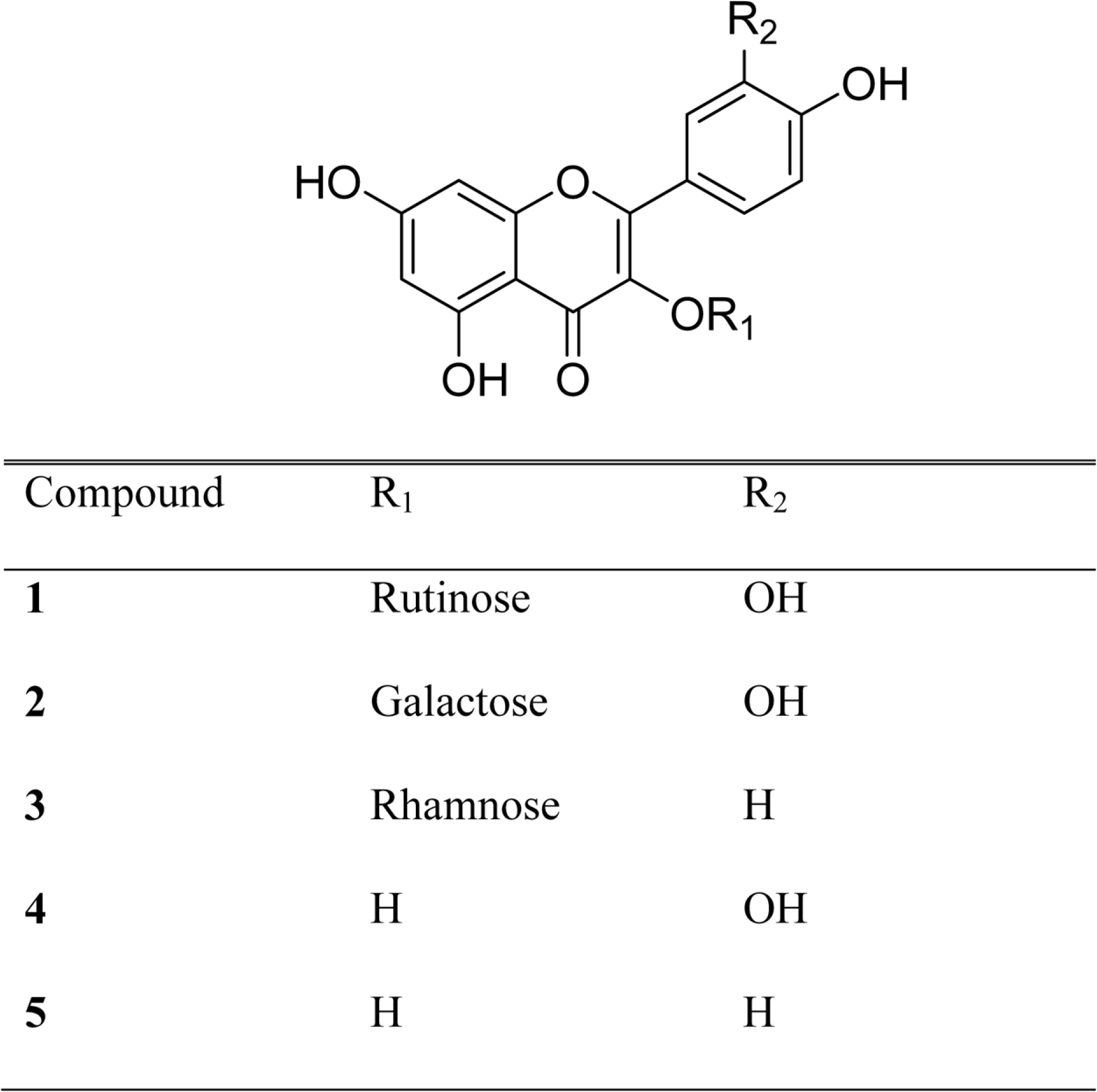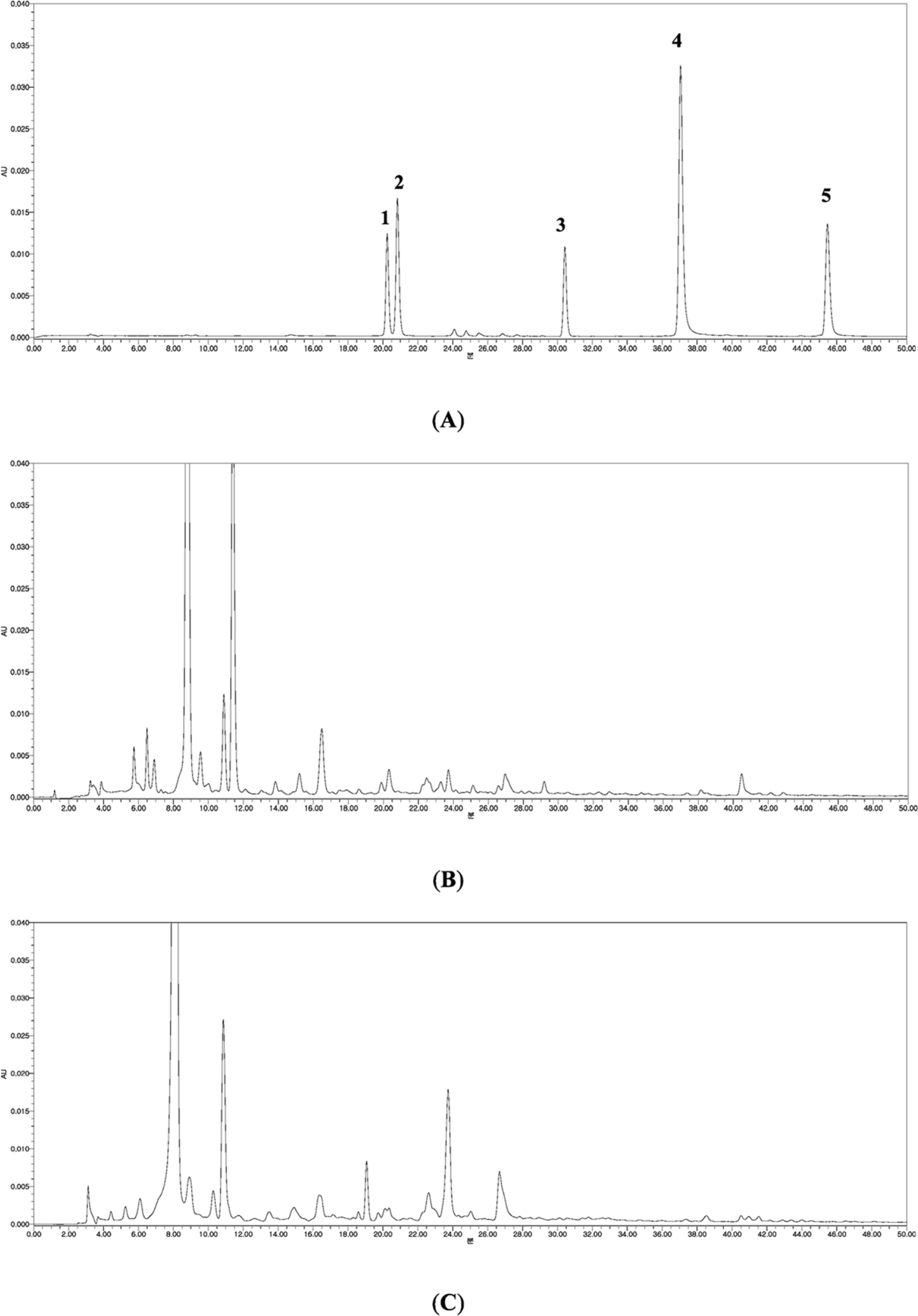Nat Prod Sci.
2016 Mar;22(1):25-29. 10.20307/nps.2016.22.1.25.
Yield Analysis of Flavonoids in Acanthopanax divaricatus and A. koreanum Grown using Different Cultivation Methods
- Affiliations
-
- 1Natural Products Research Team, National Marine Biodiversity Institute of Korea, Seocheon 33662, Korea.
- 2Department of Integrative Plant Science, Chung-Ang University, Anseong 17546, Korea. slee@cau.ac.kr
- 3Yeongcheon Agricultural Technology & Extension Center, Yeongcheon 38823, Korea.
- 4School of Applied Biosciences, Kyungpook National University, Daegu 41566, Korea.
- KMID: 2312917
- DOI: http://doi.org/10.20307/nps.2016.22.1.25
Abstract
- High-performance liquid chromatography was performed in order to analyze the changes in the flavonoid content (rutin, hyperin, afzelin, quercetin, and kaempferol) of Acanthopanax divaricatus and A. koreanum, in response to different cultivation methods (pinching height, planting time, and top dressing). The total flavonoid content of A. divaricatus and A. koreanum ranged from 0.201 to 0.690 mg/g with different pinching heights, 0.143 to 1.001 mg/g for different planting times, and 0.156 to 1.074 mg/g depending on the rate of fertilizer application. In both A. divaricatus and A. koreanum, the total flavonoid content in the upper section of the plant was greater than that in the lower section. These results demonstrate which cultivation methods maximize the flavonoid content of A. divaricatus and A. koreanum, and thus help to optimize flavonoid yields to improve production for nutraceutical, pharmaceutical, and cosmeceutical applications.
Keyword
MeSH Terms
Figure
Reference
-
(1). Boon H., Smith M.The botanical pharmacy. Quarry Press;Kingston: 1999. p. 194.(2). Lee T. B.Coloured flora of Korea. Hyang Mun Sa;Seoul: 2003. p. 811–814.(3). Hong C. E., Cho M. C., Jang H. A., Lyu S. Y. J.Toxicol. Sci. 2011; 36:661–668.(4). Lyu S. Y., Park W. B.Food Sci. Biotechnol. 2008; 17:631–636.(5). Cai X. F., Lee I. S., Dat N. T., Shen G., Kang J. S., Kim D. H., Kim Y. H.Arch. Pharm. Res. 2004; 27:738–741.(6). Han S. B., Park S. K., Ahn H. J., Yoon Y. D., Kim Y. H., Lee J. J., Lee K. H., Moon J. S., Kim H. C., Kim H. M.Int. Immunopharmacol. 2003; 3:683–691.(7). Perry L. M., Metzger J.Medicinal Plants of East and Southeast Asia. The MIT Press;Cambridge: 1980. p. 41.(8). Chang S. Y., Yook C. S., Nohara T.Chem. Pharm. Bull. 1998; 46:163–165.(9). Chang S.Y., Yook C. S., Nohara T.Phytochemistry. 1999; 50:1369–1374.(10). Ishikura N.Phytochemistry. 1975; 14:1439.(11). Miyakoshi M., Shirasuna K., Sawada H., Isoda S., Ida Y., Shoji J.Nat. Med. 1995; 49:218.(12). Shirasuna K., Miyakoshi M., Mimoto S., Isoda S., Satoh Y., Hirai Y., Ida Y., Shoji J.Phytochemistry. 1997; 45:579–584.(13). Lee S., Jung S. H., Lee Y. S., Shin K. H.Nat. Prod. Sci. 2003; 9:4–6.(14). Kim H. Y., Lee J. M., Yokozawa T., Sakata K., Lee S.Food Chem. 2011; 126:892–895.(15). Rho H. S., Ahn S. M., Lee B. C., Kim M. K., Ghimeray A. K., Jin C. W., Cho D. H.Bioorg. Med. Chem. Lett. 2010; 20:7534–7536.(16). Park H. K., Park M. S., Kim T. S., Kim S., Choi K. G., Park K. H., Korean J.Crop Sci. 1997; 42:673–677.(17). Lee J. J., Lee S. H., Park J. S., Ahn Y. S., Lee S. C., Korean J.Medicinal Crop Sci. 2013; 21:39–44.(18). Mok S. Y., Lee J. M., Kim H. M., Lee D. G., Yoon Y. H., Cho E. J., Lee S.Nat. Prod. Sci. 2011; 17:230–233.(19). Lee S., Park H. S., Notsu Y., Ban H. S., Kim Y. P., Ishihara K., Hirasawa N., Jung S. H., Lee Y. S., Lim S. S., Park E. H., Shin K. H., Seyama T., Hong J., Ohuchi K.Phytother. Res. 2008; 22:1552–1556.(20). Mok S. Y., Lee S.Food Chem. 2013; 136:969–974.(21). Kitajima J., Takamori Y., Tanaka Y.Yakugaku Zasshi. 1989; 109:188–191.(22). Lee J. M., Lee D. G., Lee K. H., Cho S. H., Park C. G., Lee S.Nat. Prod. Sci. 2013; 19:15–19.(23). Kim M. S., Kim S. Y., Lee D. S., Kor J.Intl. Agric. 2000; 12:298–302.
Article(24). Han J. S., Kim S. K., Kim S. W., Kim Y. J.Korean, J. Medicinal Crop Sci. 2001; 9:1–7.(25). Kim P. G., Lee K. Y., Hur S. D., Kim S. H., Lee E. J.Korean J. Ecol. 2003; 26:321–326.
- Full Text Links
- Actions
-
Cited
- CITED
-
- Close
- Share
- Similar articles
-
- The Effect of Acanthopanax koreanum Extract on the Induction of Collagen Induced Arthritis for DBA/1J Mice
- Evaluation of the Mutagenic Properties of Two Lignans from Acanthopanax koreanum Nakai
- First Report and Characterization of Pestalotiopsis ellipsospora Causing Canker on Acanthopanax divaricatus
- The Effect of Acanthopanax Koreanum Extract on the Induction of Collagen Induced Arthritis for DBA / 1J Mice
- The Effect of Diterpenoid Extracted from Acanthopanax Koreanum on the Collagen Indkuced Arthritis in DBA/1 Mice



